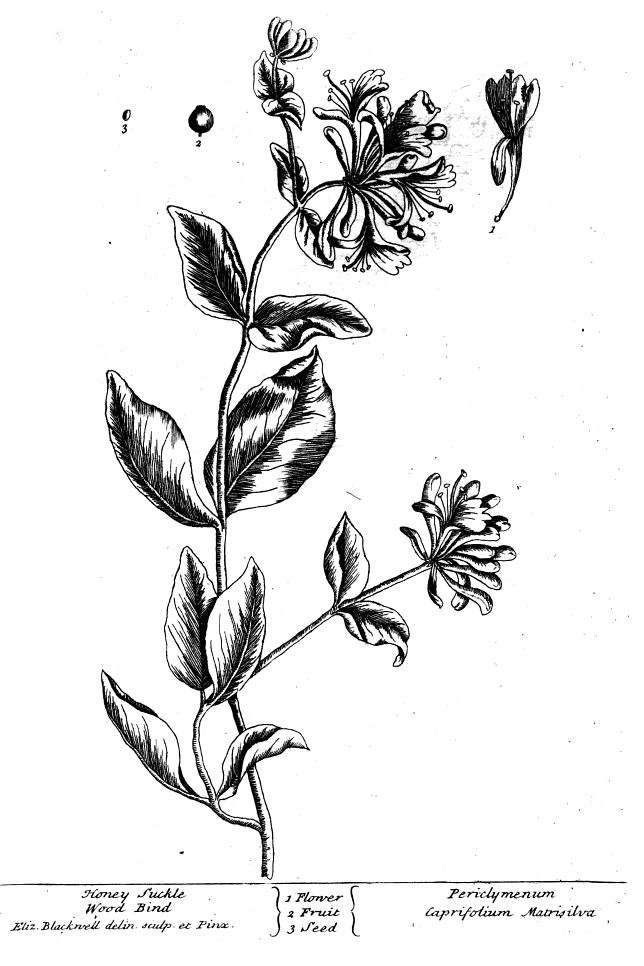Honeysuckle

Other names for Honeysuckle, Past or Present
English - Woodbine, Wood Bind
Latin - Lonicera periclymenum, Caprifolium Matrisilva (obs.)
German - Beissblatt
French - Vincibosse
Spanish - Madresilva
Dutch - Geytenblad, Mammetjes-kruyd
Italian - Vincibosco
Honeysuckle - Background & Uses
As a medicinal plant, Honeysuckle is said to have been used in cases of gastronomical distress, colds, fever and flu. In historical texts, Honeysuckle is described as an antispasmodic and anti-inflammatory. Traditional healers are said to have prepared the herb as a topical ointment for skin conditions such as scabies and boils. [1]

Honeysuckle
Image source -
https://en.wikipedia.org/wiki/File:Lonicera-linedrawing1897.svg - CC
John Gerard (1597) described Honeysuckle as being effective in treating conditions of the liver, spleen, and respiratory system. John Brickell (1737) considered Honeysuckle to have diuretic, anti-asthmatic, and antibacterial properties. Brickell also indicated that Honeysuckle was used cosmetically as a treatment for pimples, and as a remedy for nervous conditions.[2]
By the nineteenth century Honeysuckle was not discussed extensively or mentioned frequently in herbals or other texts; however, C.S. Rafinesque (1828) mentioned that a syrup made of Honeysuckle leaves was used to treat conditions of the throat and lungs.[2]
Honeysuckle - Scientific studies
Scientific research indicates that Honeysuckle (Lonicera periclymenum) might be effective in lowering cholesterol and blood pressure.[1]
Balance3, a product containing Lonierca Japonica (Japanese honeysuckle, a close relative of Lonicera periclymenum), is marketed as a dietary supplement to reduce blood pressure, boost energy levels, and encourage a sense of well-being. Balance3, which also contains Spicia prunela (All-heal flower), Chrysanthemi flos (Chrysanthemum flower), Radix notoginseng (Notoginseng root), Cleistocalyx operculatus (Water Fairy flower), Leninus edodes (Sing mushroom), and Sophora Japonica (Pagoda tree flower), has been reported to have a blood-pressure lowering effect in human test subjects.[3]
Honeysuckle in old Herbals & Pharmocopœia
Elizabeth Blackwell's "A Curious Herbal" (1751): 1. This shrub grows to the thickness of eight or ten inches in circumference, shooting out long slender stalks, which twist about every thing they meet with; the leaves are a bluish green, and the flowers a pale red; which are succeeded by Berries of a deeper red. 2. It grows in most hedges, and flowers the greatest part of the summer. 3. The leaves are sometimes put into gargarisms for sore throats. Some comend a Decoction of them for a cough and the Ptysick; and to open obstructions of ye liver and spleen. The oil, made by infusion of ye flowers, is accounted healing and warming, good for the cramp and convulsions of ye nerves. Matthiolus recommends the leaves and their juice as good in the ointments that are used for wounds in the head, and ulcers in the legs.
Honeysuckle Image

Honeysuckle
References:
[1] Heatherley, Ana Nez. Healing plants: a medicinal guide to native North American plants and herbs. 1998. The Globe Pequot Press.
[2] Crellin, J.K., Jane Philpott, A. L. Tommie Bass. Herbal Medicine Past and Present: A reference guide to medicinal plants. 1989. Duke University Press.
[3] Kershenstine, J.R. Herbal Dietary Supplement. United States Patent Application Publication: US 2004/0076641 A1.
Main article researched and created by Kelsey Wambold - herbshealthhappiness.com 2013


1. Famous Chef Sheds 60lbs Researching New Paleo Recipes: Get The Cookbook FREE Here
2. #1 muscle that eliminates joint and back pain, anxiety and looking fat
3. Drink THIS first thing in the morning (3 major benefits)
4. [PROOF] Reverse Diabetes with a "Pancreas Jumpstart"
5. Why Some People LOOK Fat that Aren't
6. Amazing Secret Techniques To Protect Your Home From Thieves, Looters And Thugs
7. The #1 WORST food that CAUSES Faster Aging (beware -- Are you eating this?)
If you enjoyed this page:



























